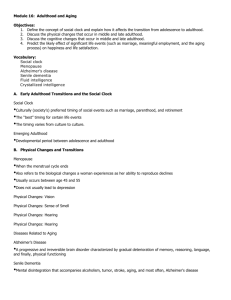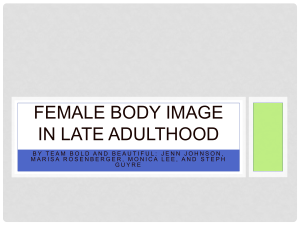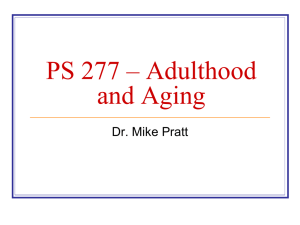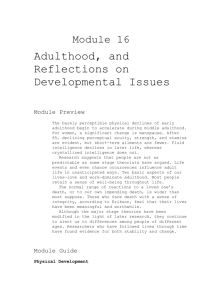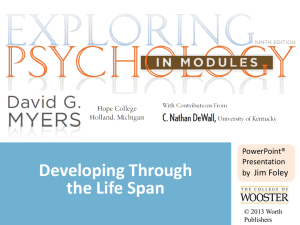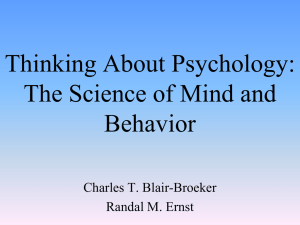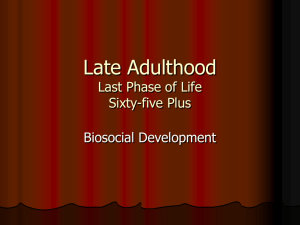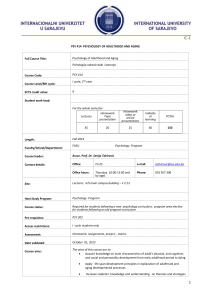Study Guide: Test 1 (Chapters 1-4)
advertisement
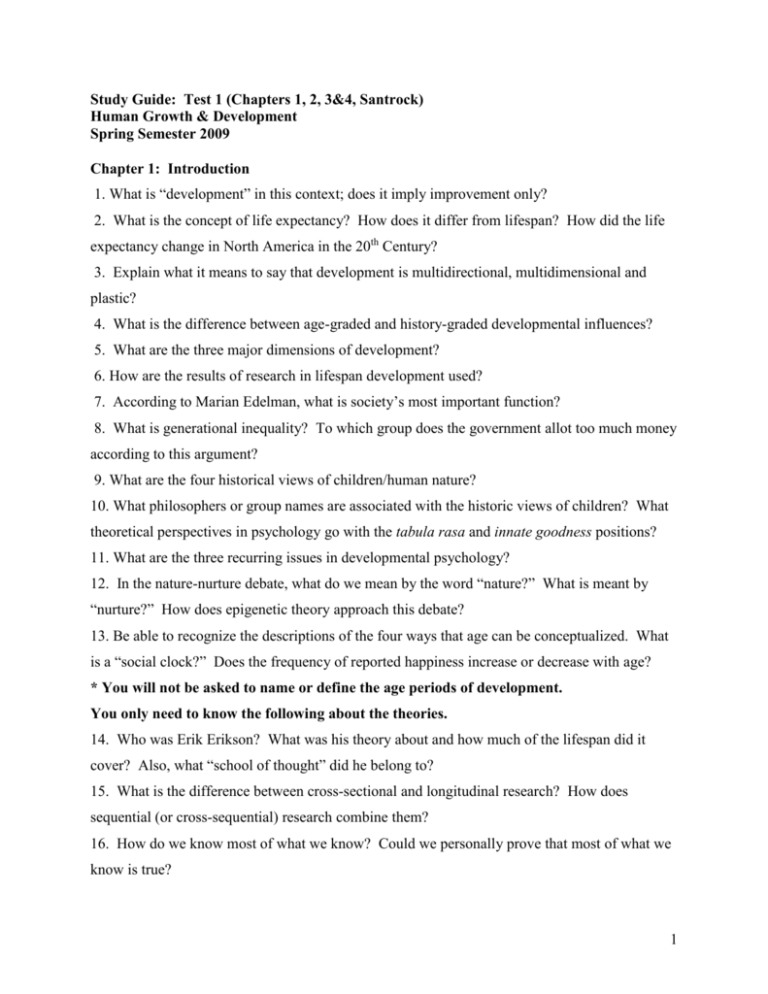
Study Guide: Test 1 (Chapters 1, 2, 3&4, Santrock) Human Growth & Development Spring Semester 2009 Chapter 1: Introduction 1. What is “development” in this context; does it imply improvement only? 2. What is the concept of life expectancy? How does it differ from lifespan? How did the life expectancy change in North America in the 20th Century? 3. Explain what it means to say that development is multidirectional, multidimensional and plastic? 4. What is the difference between age-graded and history-graded developmental influences? 5. What are the three major dimensions of development? 6. How are the results of research in lifespan development used? 7. According to Marian Edelman, what is society’s most important function? 8. What is generational inequality? To which group does the government allot too much money according to this argument? 9. What are the four historical views of children/human nature? 10. What philosophers or group names are associated with the historic views of children? What theoretical perspectives in psychology go with the tabula rasa and innate goodness positions? 11. What are the three recurring issues in developmental psychology? 12. In the nature-nurture debate, what do we mean by the word “nature?” What is meant by “nurture?” How does epigenetic theory approach this debate? 13. Be able to recognize the descriptions of the four ways that age can be conceptualized. What is a “social clock?” Does the frequency of reported happiness increase or decrease with age? * You will not be asked to name or define the age periods of development. You only need to know the following about the theories. 14. Who was Erik Erikson? What was his theory about and how much of the lifespan did it cover? Also, what “school of thought” did he belong to? 15. What is the difference between cross-sectional and longitudinal research? How does sequential (or cross-sequential) research combine them? 16. How do we know most of what we know? Could we personally prove that most of what we know is true? 1 17. What are two major factors in choosing to believe information? 18. What are the characteristics of an authoritative source? 19. What happens if the same misinformation is repeatedly told? 21. What are two of the limitations of data? 22. What is the post-modern mindset? What is socially constructed reality? 23. What is prisca sapentia? What would its existence imply? 24. What is the first step to practical critical thinking? Chapter 2: Biological Beginnings 1. Evolutionary developmental psychology is a theory based on what? What problems does it have over and above the problematic issues of classic evolution? 2. What is a chromosome? What is DNA? Describe the DNA molecule. 3. How many chromosomes do human beings have? About how many genes are we believed to have? 4. What is an autosome? What is a gene? What is a genome? 5. What affects the expression or activity of genes? 6. What is the male pattern for the 23rd chromosomal pair? The female pattern? 7. What is a gamete and how many chromosomes does it have? 8. What is a zygote? 9. What percentage of DNA within the human race is identical? 10. What is the probability of occurrence of genetically identical, non-twin siblings? 11. What is an allele? What is the difference between heterozygous and homozygous? 12. What is the difference between a genotype and a phenotype? 13. In a heterozygous child, which allele determines the characteristic, dominant or recessive ? 14. What is a carrier? 15. What are co-dominant (or incomplete dominance) patterns of genetic inheritance? 16. What is different or unique about the 23rd pair of chromosomes? 17. Are male or female offspring more likely to show X-linked, recessive characteristics? 18. What is genetic imprinting? 19. What is polygenic inheritance? 20. Why do we have such a short list of conditions caused by chromosomal abnormalities? What is the best-known one? 2 21. What is fragile X, and what do we know about it? 22. You should be able to recognize the descriptions of Down, Klinefelter, and Turner syndromes. 23. What are some indicators that a couple should consider genetic counseling? 24. What is the primary risk of using prenatal diagnostic techniques? What is often the only decision to be made? Are the results always conclusive? 25. What are two known prenatal tests that will reveal genetic defects? 26. What is preimplantation genetic diagnosis? 27. About what frequency of couples in the U.S. experience infertility? How is it defined? 28. How are identical twins different from fraternal twins? Which ones are monozygotic? How much of their genetic heritage do they share? 29. How early do environmental influences (nurture) start? 30. What is the difference between research in molecular and behavioral genetics? 31. What is a concordance rate? 32. What are canalization and reaction range in terms of epigenetic theory? 33. What are passive, evocative, and niche-picking genetic-environmental exchanges? 34. When does human development begin? 35. Where does conception normally occur? 36. What are the three periods of pregnancy from the standpoint of the developing baby? How long does each one last? What events mark the transitions among them? 37. What is implantation? 38. What does the troboblast form during the period of the zygote? 39. What are the three layers of the embryonic disk and what will each become? 40. What is the first structure to appear during the embryonic stage? What will it become? 41. What is the first notable event after the appearance of the neural tube? 42. How large is an embryo by the eighth week? 43. What is organogenesis? 44. How are the mother’s and fetus’s blood supplies connected? 45. What behaviors can the fetus engage in during the third month? 46. What happens to the brain during the second trimester? How rapidly does it happen? 47. What is the age of viability and how long after conception does it occur? (second trimester) 3 48. What are the average survival rates for babies born at 22, 26 and 28 weeks gestation? What seems to make the greatest difference? 49. You should be able to recognize problems of premature infants such as hyaline membrane disease and apnea. What is kangaroo care? 50. According to recent research, how early can a human being can feel pain? 51. What addition in the 3rd trimester will enable the newborn to regulate temperature? 52. What is a teratogen? What are the types or categories of teratogens? (drugs, diseases, pollutants) 53. Why do we call teratology the "science of risk analysis"? In other words what are the factors affecting the outcome of exposure to a teratogen? 54. Are legal, over-the-counter drugs always considered safe to take during pregnancy? 55. What are some of the outcomes associated with illegal heroin and cocaine use during pregnancy? 56. How (by what processes) does nicotine compromise normal prenatal development? How about alcohol? 57. What is the leading preventable cause of mental retardation? What other symptoms does this condition have? 58. Four infectious disease teratogens that we discussed were rubella, HIV/AIDS, genital herpes and toxoplasmosis. For each of these, what are ways that mothers can minimize the risk of birth defects for their unborn children? 59. What variable is the best available predictor of infant survival and healthy development? Why? What are three types of low birthweight babies? 60. What characteristics are measured on the Apgar, and what score ranges indicate good physical condition, need for assistance, and serious danger? 61. Do most births in the U.S. involve medication? About what percent are Caesarian deliveries? Chapter 3: Physical Development & Biological Aging & Chapter 4: Health 1. What are cephalocaudal and proximodistal growth patterns? 2. How large is the average North American newborn? 3. By the end of the second year, how close is the average child to its adult weight and height? 4. About how many inches and pounds do children grow per year? 4 5. What is skeletal age? 6. By what age does the brain reach 90% of its adult weight? 7. What is synaptogenesis? What is the pattern (cycle) of brain development after birth? 8. What guides pruning in brain development? 9. What is myelination, and what does it do for the brain? 10. About how many neurons does a person have at birth? 11. What are glial cells and what is their function? 12. To what does the order in which cortical regions develop correspond? 13. Where is there a burst of synaptic growth in the cortex during the first year? What areas show dramatic growth during toddlerhood? What is one of the last regions to develop? 14. What is cortical lateralization? Describe the typical pattern of the cortex. 15. What are the results of early brain understimulation? What does brain overstimulation do? 16. At what age does the last brain growth spurt occur? 17. What hormone(s) are needed for the development of body tissues? What is the primary hormone needed for normal nerve-cell development? 18. What is psychosocial dwarfism? What causes it? Is it treatable? 19. What is the bio-psycho-social model? 20. What percentage of deaths worldwide are due to infectious diseases? 21. What is oral rehydration therapy and what is its value? 22. What has caused a dramatic decline in childhood diseases in the industrialized world? 23. In the U.S., what is the most frequent cause of death in children over a year old? 24. What other types of accidents are leading causes of the death of young children? 25. What is otitis media and who is most likely to have it? 26. What disease has increased dramatically in frequency and is the most frequent health reason for children being absent from school? 27. What are the advantages of breast feeding? 28. Why do mothers not breast feed, or stop earlier than the recommended one year? 29. What are marasmus and kwashiorkor? 30. What problems can result from early malnutrition? 31. What is the primary nutrition problem in the U.S. and other Western nations? 32. What are the causes of childhood obesity? 5 33. What percentage of U.S. children are getting enough exercise? Why are most of them not getting enough exercise? Adolescence 1. What does it mean that adolescence is culturally defined? 2. When does puberty’s growth spurt start on average for girls? Boys? How fast does each grow? What percentage of body weight is gained during adolescence? 3. You should be able to recognize descriptions or explanations of each of the four theories of why puberty is happening earlier than it used to. 4. What difference does it make if a person goes through puberty much earlier or later than his or her peers? How are the outcomes different for males and females? 5. Describe early maturing girls and boys. 6. What are some theories about why puberty is happening earlier? 7. Describe adolescent brain development. 8. What is wrong on average with teenage nutrition? What deficiencies are found? 9. What are the consequences of obesity, and what is the best way to treat it? 10. Describe the eating disorders anorexia and bulimia nervosa. 11. How many alcoholics are there in the U.S.? 12. What are the negative effects of drinking too much on those around you? 13. What are the correlations of smoking to death-causing diseases? 14. What have been changes in smoking patterns in the U.S. in recent decades? 15. Do most teenagers try smoking, drinking and/or using a drug? 16. What type of person is more likely to become addicted? What are experimenters? 17. How does drug use in the U.S. compare to that of other nations? What type of drug is becoming an increasing source of concern with regard to abuse? 18. What does your textbook suggest as a potential factor in the prevention of drug use? 19. What is the pattern of drinking among college students? 20. What factors help to slow drinking and drug use by the mid-20’s? Adulthood 1. 29. Describe 5 ways in which the brain changes in adulthood. 2. Explain the statement that normal processes of aging in middle adulthood (not disease processes) are more a matter of vanity than disability. What is sarcopenia? 6 3. Is bone loss a normal part of aging or a disease? How early does it start? 4. What is climacteric? What is the average age of menopause? Is there an andropause? 5. What cardiovascular changes tend to happen in middle adulthood? 6. When does the immune system start to decline, and what non-age factors weaken it? 7. What are the ideal years for having children, and when is there a dramatic rise in the frequency of infertility among women? 8. What is the Western hemisphere stereotype regarding aging, and how does this correlate with health and aging itself? 9. What are the leading causes of death in middle adulthood? 10. What personality traits become serious threats to health in middle adulthood? 11. What are usually the first detected factors of cardiovascular disease? 12. What percentage of heart attack victims die before reaching the hospital? 13. What genes appear to be important in cancer prevention? 14. What percentage of people who have cancer are cured? 15. What are the most prevalent forms of cancer? 16. What is the chief symptom of adult-onset diabetes, and about what percentage of the elderly have it? What increases the risk of getting it, and how is it treated? 17. What is the difference between osteoarthritis and rheumatoid arthritis? Roughly what percentages of people over 65 have it? 18. What is the advice or treatment for people who have osteoporosis? 19. What are the four most common causes of death in older adulthood? 20. What health risks are associated with adult obesity? 21. What are some advantages of losing weight? What element do the most effective weightloss programs include? 22. What is the effect of caloric restriction on animals? 23. What functions or conditions appear to be improved among older adults when they take vitamins? 24. What does taking prescription drugs do to nutritional needs? 25. What are the benefits of exercise? 26. With what benefits is exercise associated in aging adults? 7 27. What is the “invisible epidemic” among older adults, and what may be associated health risks? 28. Does normal cell death in the brain due to aging render a person incapable of conducting daily activities? 29. What is dementia? About what percentage of people over age 80 have Alzheimer disease? What are the symptoms as it progresses? 30. What are plaques and tangles? What is the difference between familial and sporadic Alzheimer disease? What are some suggested risk factors for Alzheimer’s? Protective factors? 31. What is cerebrovascular dementia, and what are its causes/risk factors? 32. What is Parkinson Disease and what types of neurons are involved? What are the symptoms? 33. What are reversible dementias? Name some examples. 34. What are the statistical comparisons for older adults and others with regard to motor vehicle accidents? What are the statistics for falls among older adults? What are some associated physical reasons? 35. What were 4 findings of the Mankato nun study? 36. How does cellular clock theory explain aging and death? What is a telomere? 37. What is a free-radical? What substances are supposed to neutralize free radicals? 38. What is the mitochondrial theory of aging and how is it linked to free-radical theory? 39. Describe the hormonal stress theory of aging. 8

